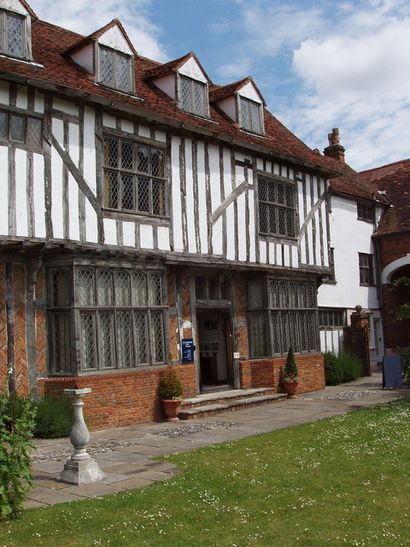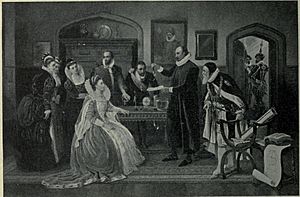William Gilbert (physicist) facts for kids
Quick facts for kids
William Gilbert
|
|
|---|---|

William Gilbert
|
|
| Born | 24 May 1544 |
| Died | 30 November 1603 (aged 59) London, England
|
| Nationality | English |
| Education | St John's College, Cambridge (MD, 1569) |
| Known for | Studies of magnetism, De Magnete |
| Scientific career | |
| Fields | Physician |
William Gilbert (born May 24, 1544? – died November 30, 1603) was an English doctor and scientist. He is also known as Gilberd. Gilbert is famous for his important book, De Magnete (published in 1600). In this book, he wrote about his studies on magnetism and electricity.
A unit used to measure magnetomotive force was once named the Gilbert in his honor. This unit is now called the Ampere-turn.
Contents
William Gilbert's Life and Discoveries
William Gilbert was born in Colchester, England. His father, Jerome Gilberd, was a local judge. William studied at St John's College, Cambridge. He became a doctor in 1569. After working at Cambridge for a short time, he moved to London to practice medicine. He also traveled around Europe.
In 1573, Gilbert became a member of the Royal College of Physicians. He was later chosen as the President of the college in 1600. From 1601 until her death in 1603, he was the personal doctor to Queen Elizabeth I. King James I also kept him as his doctor.
Earth as a Giant Magnet
Gilbert's main scientific book was De Magnete, Magneticisque Corporibus, et de Magno Magnete Tellure. This long title means On the Magnet and Magnetic Bodies, and on the Great Magnet the Earth. He published it in 1600. In this book, he described many experiments he did with a model Earth. He called this model a terrella.
From his experiments, Gilbert figured out that the Earth itself acts like a giant magnet. This was a big discovery! It explained why compasses always point north. Before Gilbert, some people thought a star or a magnetic island at the North Pole pulled compasses. Gilbert was also the first to suggest that the center of the Earth is made of iron. He also showed that if you cut a magnet, each piece becomes a new magnet with its own north and south poles.
Understanding Electricity
Gilbert also studied static electricity. He used amber in his experiments. Amber is a fossilized tree resin that can attract light objects when rubbed. The Greek word for amber is elektron. Because of this, Gilbert decided to call the force that amber created the electric force. This is where the word "electricity" comes from!
He also invented the first tool to measure electrical effects. It was a pivoted needle he called the versorium. This tool could show if an object was electrically charged.
Gilbert believed that electricity and magnetism were different forces. He thought that heat made electrical attraction disappear, but not magnetic attraction. However, we now know that strong heat can weaken magnets too. Later, scientists like Hans Christian Ørsted and James Clerk Maxwell showed that electricity and magnetism are actually two parts of one force, called electromagnetism.
Thoughts on the Universe
Gilbert also had interesting ideas about the universe. He argued that the Earth spins every day. This was a new idea for many people at the time. He thought it was silly to believe that huge celestial spheres (imaginary clear balls holding the stars) rotated daily. He thought it made more sense for the much smaller Earth to spin.
He also believed that the "fixed" stars were not all at the same distance from Earth. He thought they were at different, far-off distances. This was different from the common idea that stars were stuck to one big sphere.
Gilbert also made one of the first maps of the Moon in the 1590s. He did this without a telescope. His map showed dark and light areas on the Moon's surface. He thought the light spots were water and the dark spots were land.
Gilbert's Later Work and Death
After Gilbert's death, another book of his was published in 1651. It was called De Mundo Nostro Sublunari Philosophia Nova, which means New Philosophy about our Sublunary World. This book showed more of Gilbert's ideas about how the world works. He challenged older ideas from Aristotle.
William Gilbert died on November 30, 1603, in London. It is believed he died from the bubonic plague. He was buried in his hometown, at Holy Trinity Church in Colchester. You can still see his marble monument there today. The church is now used as a café and market.
See also
 In Spanish: William Gilbert para niños
In Spanish: William Gilbert para niños
- History of geomagnetism
- List of geophysicists
- Scientific revolution



